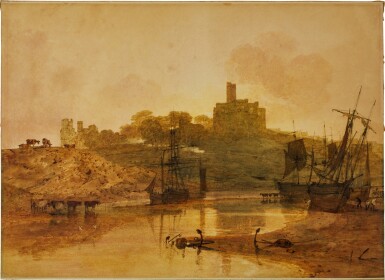Master Works on Paper from Five Centuries
Master Works on Paper from Five Centuries

Property from the Beaverbrook Art Gallery, Sold to Benefit Future Acquisitions
Joseph Mallord William Turner, R.A.
Warkworth Castle, Sunset
Auction Closed
July 5, 10:16 AM GMT
Estimate
30,000 - 50,000 GBP
Lot Details
Description
Property from the Beaverbrook Art Gallery, Sold to Benefit Future Acquisitions
Joseph Mallord William Turner, R.A.
London 1775 - 1851
Warkworth Castle, Sunset
Watercolour over pencil, heightened with pen and brown-black ink
365 by 507 mm
John Temple Leader (1810-1903),
his sale, London, Christie’s, 18 March 1843, lot 49, bt 'Rought', £22 11s 6d;
John Dillon (d. 1869);
his executor's sale, London, Christie’s, 29 April 1869, lot 132, bt 'Agnew's', £105;
with Agnew's, London,
Abel Buckley (1835-1908), 1904;
Thomas W. Wright, 1905,
his sale, London, Christie’s, 27 April 1923, lot 96; bt 'Leggatt', £304;
with Appleby Brothers Ltd, London,
acquired by Lord Beaverbrook in 1957, by whom gifted to the Beaverbrook Art Gallery in 1959
London, Agnew’s, 1905, no. 36
In this large-scale watercolour Turner looks west across the river Coquet towards the mighty fortress of Warkworth, a Percy family stronghold since the fourteenth century, which is situated close to the rugged Northumberland coast, a few miles to the south of their principal seat, Alnwick Castle. It is the end of the day and while the sun is setting, shadows lengthen across the landscape, reflections shimmer in the river’s limpid depths, smoke lazily raises from the chimney a riverside house and the boats are in the process of melting into inky silhouettes.
Warkworth Castle, Sunset dates to 1799 and is one of two finished watercolours of this subject that Turner made at around this date.1 Both works take as their genesis his sketching tour to the north of England of 1797.
This tour has been described as ‘one of the most important of his career’, for he went in search castles and abbeys but fell in love with the grandeur of the natural world – perhaps the central theme in his life’s work.2 The catalyst for the tour had been an invitation from Edward Lascelles, elder son of the 1st Lord Harewood, to stay at the family’s magnificent new seat – Harewood House – in Yorkshire. If the prospect of spending time with such an important - and rich - patron of the arts was not pleasing enough, in the early summer of 1797, Turner was likely to have been in high spirits, having received nothing but glowing reviews from the critics during that year’s Royal Academy exhibition.3
Turner seems to have left London in late June and he was not to return until the last days of August. Following in the footsteps of his friend and rival Thomas Girtin, who had carried out a northern tour in 1796, Turner travelled as far north as Berwick-upon-Tweed, as far east as the Humber estuary, and as far west as Lancaster Sands. As would become his habit, he recorded all that interested him in leather-bound sketchbooks. In this tour’s case he used the so-called North of England sketchbook and the Tweed and Lakes sketchbook. Both are now held at Tate Britain as part of the Turner Bequest, the first, containing over ninety pencil drawings and inscribed on the cover by Turner: Derbyshire, Yorkshire, Durham, Northumberland, Tweedale Scotd [sic], Lincolnshire, Northamptonshire, the second containing over eighty drawings and its cover inscribed: Yorkshire, Tweed, Lakes of Cumberland.
Upon Turner’s return to London these sketchbooks were stored away for later use. Although Turner’s year had been busy, it was not finished, for Lascelles had commissioned him to paint two large oils for the drawing room at Harewood and in September he was due to stay at Stourhead, Wiltshire with the banker and collector, Sir Richard Colt Hoare.
When Turner decided to paint the present watercolour he certainly referred back to his North of England sketchbook, where there are five pencil drawings of the castle.4 It has also been suggested that he took inspiration from his watercolour sketches of shipping, which he recorded in his so-called Cyfarthfa sketchbook during his time on the Avon Gorge and in Wales in 1798.5
Although it was Warkworth Castle, Northumberland – Thunderstorm approaching at sunset, that Turner chose to submit to the 1799 Royal Academy exhibition, the present work has an interesting history and provenance. Its first owner was William Leader, a prosperous distiller and member of parliament, whose father had been coachmaker to the Prince of Wales, later George IV. Leader was an early supporter of the young artist and owned two of Turner’s watercolours of Conway Castle and a - now lost - marine subject in oils. A later owner was John Dillon, the London haberdasher. He also owned multiple works by Turner, lending seven to the Manchester Art Treasures exhibition in 1857. Another important former owner was Thomas W. Wright who also possessed The Lake of Lucerne, Moonlight, the Rigi in the Distance, a work that he presented to the Whitworth Art Gallery, Manchester in 1891.6 In 1951 the work was acquired by Canadian-British newspaper baron, William Maxwell ‘Max’, 1st Lord Beaverbrook and it has formed part of the Beaverbrook Art Gallery - established in 1959 - until today.
We are grateful to Ian Warrell and Greg Smith for their help when cataloguing this lot.
1. E. Shanes, Young Mr Turner, the first forty years, London 2016, p. 172, no. 210
2. D. Hill, Turner in the North, New Haven 1997, p. 1
3. For example, Turner’s oil Moonlight a study at Millbank was said to be 'equal to the best pictures of Rembrandt’, while his watercolour Transept of Ewenny Priory, Glamorganshire was hailed as ‘one of the grandest drawings’ ever seen at Somerset House.
4. Warkworth Castle from the south-east, River Coquet in foreground (TB XXXIV 38) is particularly close to the present composition.
5. Cyfarthfa Sketchbook Tate Britain, TB D01656-1661 & DO1672 256 1478
6. The University of Manchester, acc. no. D.1887.16
